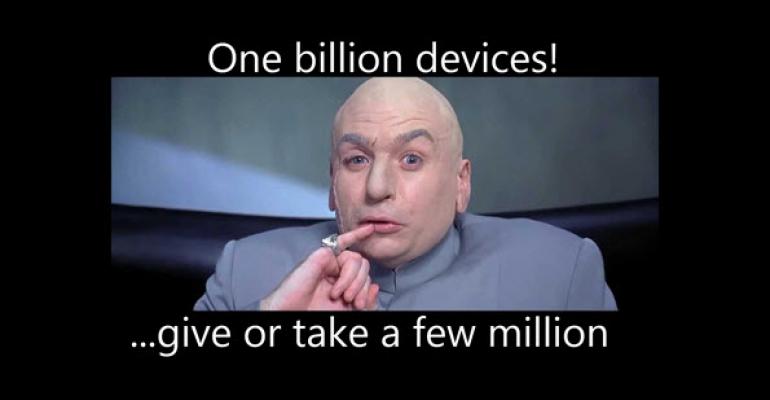During BUILD 2015, Microsoft announced their very ambitious goal to see Windows 10 installed on 1 billion devices in the first 2-3 years after its release.
Go big or go home, right?
Well, sometimes goals have to be adjusted -- and Microsoft is apparently tweaking their billion-device goal for Windows 10.
Here was how Microsoft's Terry Myerson, Executive Vice President of the Windows and Devices Group, laid out that original goal:
"Today we shared our bold goal – to see Windows 10 on one billion devices within two to three years of Windows 10’s availability – the first platform version, in any ecosystem, to be available on one billion devices. We will accomplish this by delivering Windows 10 with a free upgrade offer, making it easy for customers and businesses to upgrade quickly, and with great new devices..."
Goals should meet the following criteria and are usually developed using the SMART mnemonic:
- S - Specific
- M - Measurable
- A - Attainable
- R - Relevant
- T - Time-Bound
The original goal from Terry Myerson certainly seemed to meet all of those elements.
Of course, some goals that initially seemed attainable will appear less so after time passes. So it goes with the idea that Windows 10 will be available on one billion devices.
We all adjust goals as we get down to the hard work of meeting them. In this case, walking back the "one billion devices" benchmark actually shows maturity in realizing the initial goal was over ambitious. Redefining the goal is better than plowing down a path despite knowing you will never succeed.
So as Microsoft arrives at a realization about their initial ambitious goal is not attainable in the specified time frame, does it ultimately matter in the scheme of things?
It actually does not matter one iota.
Eventually Windows 10 will reach one billion devices - just not in the first three years. I believe Windows 10 will be close, within a couple hundred million units, within the next two years. This especially likely as Windows 10 is a cross platform operating system now found on PCs, tablets, mobile handsets, Xbox One, HoloLens, IoT devices and Surface Hubs.
So why did Microsoft admit to falling short of the billion-device goal today, on the verge of releasing the second major update for the operating system in less than a year?
I mean they have added over 350 million devices to the Windows 10 install base in the first year right? If you do the math and extrapolate that out for two more years then by July 2018, the original goal date, they should exceed their goal by at least 50 million devices, right?
Wrong. One big ticket item that will limit new additions to the Windows 10 user base is the expiration of the free upgrade offer for Windows 7 and 8.1 systems on July 29, 2016.
That upgrade targeted the Windows 7 and 8.1 install base, and has garnered a vast majority of the 350 million active users Microsoft currently shows on Windows 10. After July 29, those upgrades will cost $120 for Windows 10 Home and $199 for Windows 10 Pro.
A second limiting factor: the post-PC world. The reality is that most customers get their next version of Windows when they purchase new hardware from various OEMs. As the PC market remains in decline, that process is not going to add new devices at the same pace of a very aggressively pushed upgrade.
If you're looking for growth in Windows 10, look at enterprise migrations. There are sure to be more coming in the next year or two.
In fact, at their Worldwide Partner Conference this week, Microsoft's Yusuf Mehdi shared that over 90% of their corporate customers are actively trialing Windows 10 as they work towards their own migrations.
Old habits die hard and many corporations avoid a new version of Windows, waiting for the first Service Pack to be released, so that slows migrations down as well.
True, under Windows as a Service there is no such thing as a Service Pack anymore, but those organizations are still going to approach this cautiously.
Microsoft supports them with their servicing branches (Current Branch, Current Branch for Business and Long Term Servicing Branch) that allow companies to remain on stable builds as they test their systems and apps for compatibility between major updates. And slowly, they'll add to the numbers of Windows 10 users.
I do not expect Microsoft to announce a new goal or adjust the time frame or numbers around their original goal - they don't need to.
Microsoft is proving to its users that they can deliver solid updates to their core operating system across multiple devices and then maintain that OS by issuing cumulative updates every month to address security, bugs, stability and performance.
They have been working towards this since they began with Microsoft Azure and Office 365 over six and five years ago respectively. By issuing active updates each month with that same as a Service approach being integrated into everything they do they have proved they are nimble enough to meet these expectations.
Not one of those expectations require that they get Windows 10 onto 1 billion devices by July 2018.
But, wait...there's probably more so be sure to follow me on Twitter and Google+.





